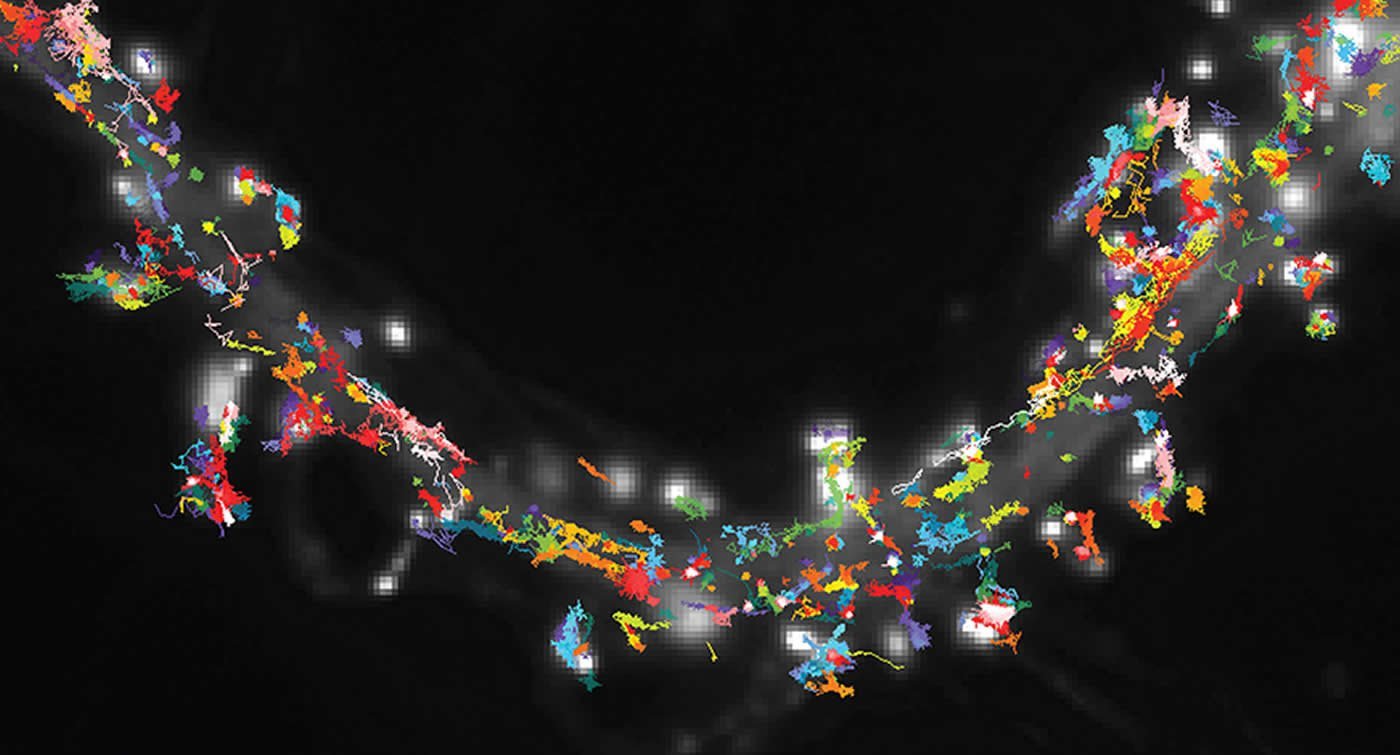Summary: Study reveals receptor movement is essential for synaptic plasticity as a response to neural activity. Halting receptor movement may block specific memory acquisition, researchers report, thus confirming the role of synaptic plasticity in learning and memory.
Source: CNRS.
Researchers in Bordeaux recently discovered a new mechanism for storing information in synapses and a means of controlling the storage process. The breakthrough moves science closer to unveiling the mystery of the molecular mechanisms of memory and learning processes. The research, carried out primarily by researchers at the Interdisciplinary Institute for Neurosciences (CNRS/Université de Bordeaux) and the Bordeaux Imaging Center (CNRS/Université de Bordeaux/Inserm), appears in the 13 september 2017 edition of Nature.
Communication between neurons passes through over one million billion synapses, tiny structures the tenth of the width of a single hair, in an extremely complex process. Synaptic plasticity – the ability of synapses to adapt in response to neuronal activity – was discovered nearly 50 years ago, leading the scientific community to identify it as a vital functional component of memorisation and learning.
Neurotransmitter receptors – found at the synapse level – play a key role in the transmission of nerve messages. A few years ago, the team of researchers in Bordeaux discovered that neurotransmitter receptors were not immobile as thought previously, but in a constant state of agitation. They posited that controlling this agitation through neuronal activity could modulate the effectiveness of synaptic transmission by regulating the number of receptors present at a given time in a synapse.

Pathways of neurotransmitter receptors followed by detecting single molecules at the surface of a rat hippocampal cultured neuron. Credit: Benjamin COMPANS/Daniel CHOQUET/IINS/CNRS Photo library.
The new research has taken the two teams further in their understanding of the basic mechanisms behind how information is stored in the brain. Scientists combined techniques based on chemistry, electrophysiology and high-resolution imaging to develop a new method to immobilise receptors at synaptic sites. This method successfully stops receptor movement, making it possible to study the impact of the immobilisation on brain activity and learning ability. It provides evidence that receptor movement is essential to synaptic plasticity as a response to intense neuronal activity.
Researchers also explored the direct role of synaptic plasticity in learning. By teaching mice to recognise a specific environment, they show that halting receptor movement can be used to block the acquisition of this type of memory, confirming the role of synaptic plasticity in this process.

Staining of receptors and pit for endocytosis, the process by which molecules are transported inside a cell NeuroscienceNews.com image is credited to Jennifer Petersen/Daniel Choquet/IINS/CNRS Photo library.
The discovery offers new perspectives on controlling memory. The memorisation protocol tested here activates a particular area of the brain: the hippocampus. The next step for researchers is to determine if the mechanism discovered can also be applied to other forms of learning and, by extension, to other areas of the brain. From a technical standpoint, it will be possible to develop new, reversible and light-sensitive methods of immobilizing receptors in order to better control the process.
Source: Alexiane Agullo – CNRS
Image Source: NeuroscienceNews.com images are credited to Jennifer Petersen/Daniel Choquet/IINS/CNRS Photo library/Benjamin Compans.
Original Research: Abstract for “Hippocampal LTP and contextual learning require surface diffusion of AMPA receptors” by A. C. Penn, C. L. Zhang, F. Georges, L. Royer, C. Breillat, E. Hosy, J. D. Petersen, Y. Humeau & D. Choquet in Nature. Published online September 13 2017 doi:10.1038/nature23658
[cbtabs][cbtab title=”MLA”]CNRS “A New Mechanism For Controlling Memory.” NeuroscienceNews. NeuroscienceNews, 16 September 2017.
<https://neurosciencenews.com/memory-mechanism-control-7502/>.[/cbtab][cbtab title=”APA”]CNRS (2017, September 16). A New Mechanism For Controlling Memory. NeuroscienceNew. Retrieved September 16, 2017 from https://neurosciencenews.com/memory-mechanism-control-7502/[/cbtab][cbtab title=”Chicago”]CNRS “A New Mechanism For Controlling Memory.” https://neurosciencenews.com/memory-mechanism-control-7502/ (accessed September 16, 2017).[/cbtab][/cbtabs]
Abstract
Hippocampal LTP and contextual learning require surface diffusion of AMPA receptors
Long-term potentiation (LTP) of excitatory synaptic transmission has long been considered a cellular correlate for learning and memory. Early LTP (less than 1 h) had initially been explained either by presynaptic increases in glutamate release or by direct modification of postsynaptic AMPA (α-amino-3-hydroxy-5-methyl-4-isoxazolepropionic acid) receptor function. Compelling models have more recently proposed that synaptic potentiation can occur by the recruitment of additional postsynaptic AMPA receptors (AMPARs), sourced either from an intracellular reserve pool by exocytosis or from nearby extra-synaptic receptors pre-existing on the neuronal surface. However, the exact mechanism through which synapses can rapidly recruit new AMPARs during early LTP remains unknown. In particular, direct evidence for a pivotal role of AMPAR surface diffusion as a trafficking mechanism in synaptic plasticity is still lacking. Here, using AMPAR immobilization approaches, we show that interfering with AMPAR surface diffusion markedly impairs synaptic potentiation of Schaffer collaterals and commissural inputs to the CA1 area of the mouse hippocampus in cultured slices, acute slices and in vivo. Our data also identify distinct contributions of various AMPAR trafficking routes to the temporal profile of synaptic potentiation. In addition, AMPAR immobilization in vivo in the dorsal hippocampus inhibited fear conditioning, indicating that AMPAR diffusion is important for the early phase of contextual learning. Therefore, our results provide a direct demonstration that the recruitment of new receptors to synapses by surface diffusion is a critical mechanism for the expression of LTP and hippocampal learning. Since AMPAR surface diffusion is dictated by weak Brownian forces that are readily perturbed by protein–protein interactions, we anticipate that this fundamental trafficking mechanism will be a key target for modulating synaptic potentiation and learning.
“Hippocampal LTP and contextual learning require surface diffusion of AMPA receptors” by A. C. Penn, C. L. Zhang, F. Georges, L. Royer, C. Breillat, E. Hosy, J. D. Petersen, Y. Humeau & D. Choquet in Nature. Published online September 13 2017 doi:10.1038/nature23658






